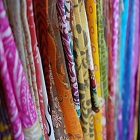
The report of the Working Group constituted by the Planning indian textile export 3Commission on India’s exports during 12th Five Year Plan, envisages exports of textiles and clothing at $64.41 billion by the end of March 2017, which given the current situation and numbers looks unachievable. Considerable decline in textile exports
Exports of fibres decreased over 36 per cent up to February last fiscal, while some other textile items witnessed just a 0.4 per cent rise, primarily due to a slowdown in the Chinese market, which accounts for over 70 per cent of India’s cotton and 40 per cent of yarn supplies. Consequently, exports of raw cotton, including waste, dropped almost 47 per cent during the April-February period from a year before.
Experts believe that with demand from China remaining dull and the government withdrawing some export incentives to the sector, shipment target for the current fiscal would be hard to achieve, especially in view of stiff competition from countries like Vietnam, Bangladesh and Pakistan. Neighbouring countries like Vietnam are showing a positive rise in exports. In 2000, Vietnam had a share of only 0.1 per cent in the US imports, which increased to 8 per cent in 2013, making it the second largest supplier country in the US market after China, according to US Department of Commerce.
Similarly, Bangladesh increased its trade share from 4 per cent in 2000 to 11 per cent in 2013 to EU, making it the third largest supplier country in EU-28 market after China and Turkey. Slowdown in the emerging markets like China, Turkey, Brazil, and Russia and developed countries like the member states of the European Union, Canada and Japan are further impacting export growth of India. Industry unsure of achieving growth target
Though a slowdown in China, political unrest in Bangladesh and labour and other issues in Vietnam gave an opportunity to Indian textile exporters, the segment managed to expand its performance rate by just 8.2 per cent over the last three years. While the average annual growth rate of Chinese textile and clothing exports slowed to 6.1 percent since 2012 from as high as 20.1 per cent in 2011, India’s average expansion rate is just 8.2 percent against 15.8 per cent growth rate reported by Vietnam since 2012. Even Bangladesh, despite all the challenges it has been facing, has managed a growth rate of 7.8 per cent.
Experts blame lack of incentives, excessive emphasis on cotton fibre and handlooms by the government, flip-flop in raw material policy, faulty duty structure in the man-made fibre segment where imports of certain raw materials like PTA are taxed higher than those of finished products and inflexible labour laws as hurdles to the growth of the textile and apparel sector. The withdrawal of certain export incentives in the recently-announced foreign trade policy 2015-20 will further make a negative impact.
India’s overall textile and garment exports grew just 5 percent in the last fiscal. While the Textile Ministry has sought a quick resolution of the India-EU free trade agreement, the ministry has also asked for the continuation of the interest subvention scheme, which was withdrawn from late 2014. Currently domestic textile exporters are given a 2 percent export incentive for outbound shipments only to the US, the EU, Canada and Japan but the industry wants incentives to capture markets in countries such as Bangladesh, Vietnam and Cambodia.
On the positive side, the Dun & Bradstreet Report says, manufacturing infrastructure in the textilesector will benefit from the government’s ‘Make in India’ campaign and domestic demand will improve in the coming quarters as economic growth sentiment improves. Increasing labour cost in China will impact cost competitiveness of Chinese textile mills in export markets, creating an opportunity for Indian mills. Exports to Latin American and Asian countries will increase, offsetting slowdown in the European Union region.
texmin.nic.in













